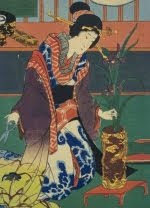Tropical materials.
Surfaces of leaves, keeping in mind the shape of the vase, contrast colours.
I couldn't resist making a quick arrangement using a few leaves and a flower from the gardens of the hotel I'm staying in at Bang Tao beach, Phuket. They have a wonderful garden with a lot of plants that I'm not familiar with, but also a few that I know - even lotus flowers!
In this arrangement I have intertwined some thin Spider Lily (Hymenocallis) leaves with the larger leave from a Parakeet flower (Heliconia Psittacorum), and finishing by sticking a red flower of Indian Head Ginger (Costus woodsonii). It has very small flowers coming out one by one from the red conic shape.
Surfaces of leaves, keeping in mind the shape of the vase, contrast colours.
I couldn't resist making a quick arrangement using a few leaves and a flower from the gardens of the hotel I'm staying in at Bang Tao beach, Phuket. They have a wonderful garden with a lot of plants that I'm not familiar with, but also a few that I know - even lotus flowers!
In this arrangement I have intertwined some thin Spider Lily (Hymenocallis) leaves with the larger leave from a Parakeet flower (Heliconia Psittacorum), and finishing by sticking a red flower of Indian Head Ginger (Costus woodsonii). It has very small flowers coming out one by one from the red conic shape.


.jpg)












